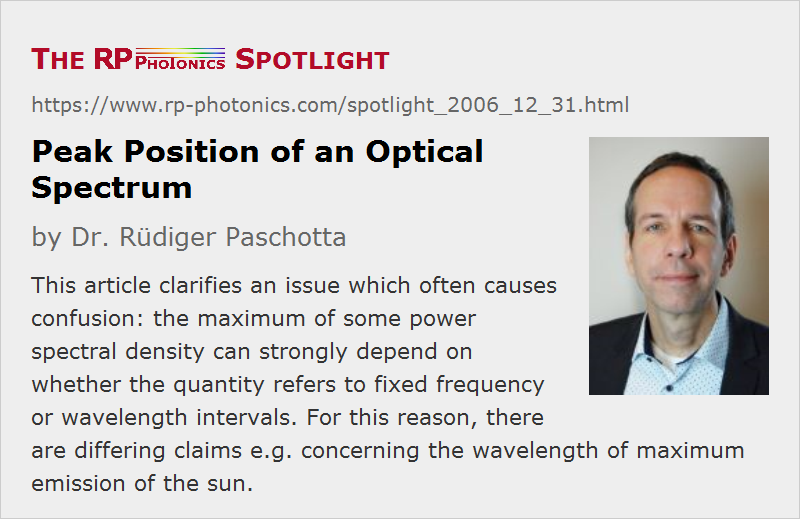Peak Position of an Optical Spectrum
Posted on 2006-12-31 as part of the Photonics Spotlight (available as e-mail newsletter!)
Permanent link: https://www.rp-photonics.com/spotlight_2006_12_31.html
Author: Dr. Rüdiger Paschotta, RP Photonics AG, RP Photonics AG
Abstract: This article clarifies an issue which often causes confusion: the maximum of some power spectral density can strongly depend on whether the quantity refers to fixed frequency or wavelength intervals. For this reason, there are differing claims e.g. concerning the wavelength of maximum emission of the sun.

Ref.: encyclopedia articles on power spectral density, Fourier spectrum, bandwidth
A frequently asked question is at what wavelength some optical spectrum – e.g., the spectrum of solar radiation – has its peak. This sort of question looks very innocent, and many people fall into the trap. For that reason, some claim that solar emission is maximum in the green spectral region (where human eyes happen to be most sensitive), while others locate it in the near infrared. Let's look into this issue.
For any kind of optical emission spectrum, one is looking at some amount of energy, power, intensity or alike which is distributed over some range of wavelengths or optical frequencies. One may define a power spectral density e.g. as a power per unit frequency interval, e.g. in units of watts per terahertz, and plot this kind of spectral intensity as a function of optical frequency. Alternatively, one may define a spectral intensity in terms of wavelength (rather than frequency) intervals, e.g. in units of watts per nanometer. The above-mentioned trap is then associated with the conversion between nanometers and terahertz: for infinitesimal frequency and wavelength intervals, we have <$\Delta\nu = (c / \lambda^2) \: \Delta\lambda$>, i.e., the conversion factor strongly depends on the wavelength! At shorter wavelengths, each nanometer is worth more terahertz. Exactly for this reason, the maximum of power density occurs at a shorter wavelength when the quantity refers to wavelength rather than frequency intervals. This is graphically illustrated in the article on power spectral density. A frequently seen mistake is to simply convert the independent variable while forgetting to apply the factor <$c / \lambda^2$>. And related to this mistake is another one: asking questions about the maximum of the power density without clarifying which one is really meant.
Another caveat occurs when converting intensity into photon flux, where the latter takes into account only the number of photons, but not their energy. And when it comes to the brightness of a laser, there is another wavelength-dependent factor associated with the fact that for a given beam quality, characterized e.g. with an M2 factor, shorter wavelengths can be better focused.
Of course, all these errors are most severe for light with large bandwidth. We discussed the example of sunlight, and the same happens for ultrabroadband spectra e.g. from certain mode-locked titanium–sapphire lasers.
This article is a posting of the Photonics Spotlight, authored by Dr. Rüdiger Paschotta. You may link to this page and cite it, because its location is permanent. See also the RP Photonics Encyclopedia.
Note that you can also receive the articles in the form of a newsletter or with an RSS feed.
Questions and Comments from Users
Here you can submit questions and comments. As far as they get accepted by the author, they will appear above this paragraph together with the author’s answer. The author will decide on acceptance based on certain criteria. Essentially, the issue must be of sufficiently broad interest.
Please do not enter personal data here; we would otherwise delete it soon. (See also our privacy declaration.) If you wish to receive personal feedback or consultancy from the author, please contact him, e.g. via e-mail.
By submitting the information, you give your consent to the potential publication of your inputs on our website according to our rules. (If you later retract your consent, we will delete those inputs.) As your inputs are first reviewed by the author, they may be published with some delay.


Share this with your friends and colleagues, e.g. via social media:
These sharing buttons are implemented in a privacy-friendly way!